Managing People and Systems: Leadership Styles for Millennials
VerifiedAdded on 2023/06/18
|8
|2029
|128
Essay
AI Summary
This essay explores the adaptation of leadership styles to effectively manage the millennial generation in the modern workplace. It defines leadership, discusses various leadership styles such as transformational, participative, autocratic, and bureaucratic, and examines the characteristics and challenges posed by the millennial generation, including their need for autonomy, work-life balance, and comfort with digital technology. The essay argues that the participative leadership style is best suited for managing millennials, as it promotes collaboration, fosters an egalitarian environment, bridges the inter-generational gap, and supports work-life balance. The report concludes that by adopting participative leadership, businesses can attract and retain skilled millennial employees, enhance their employer image, and achieve organizational success.
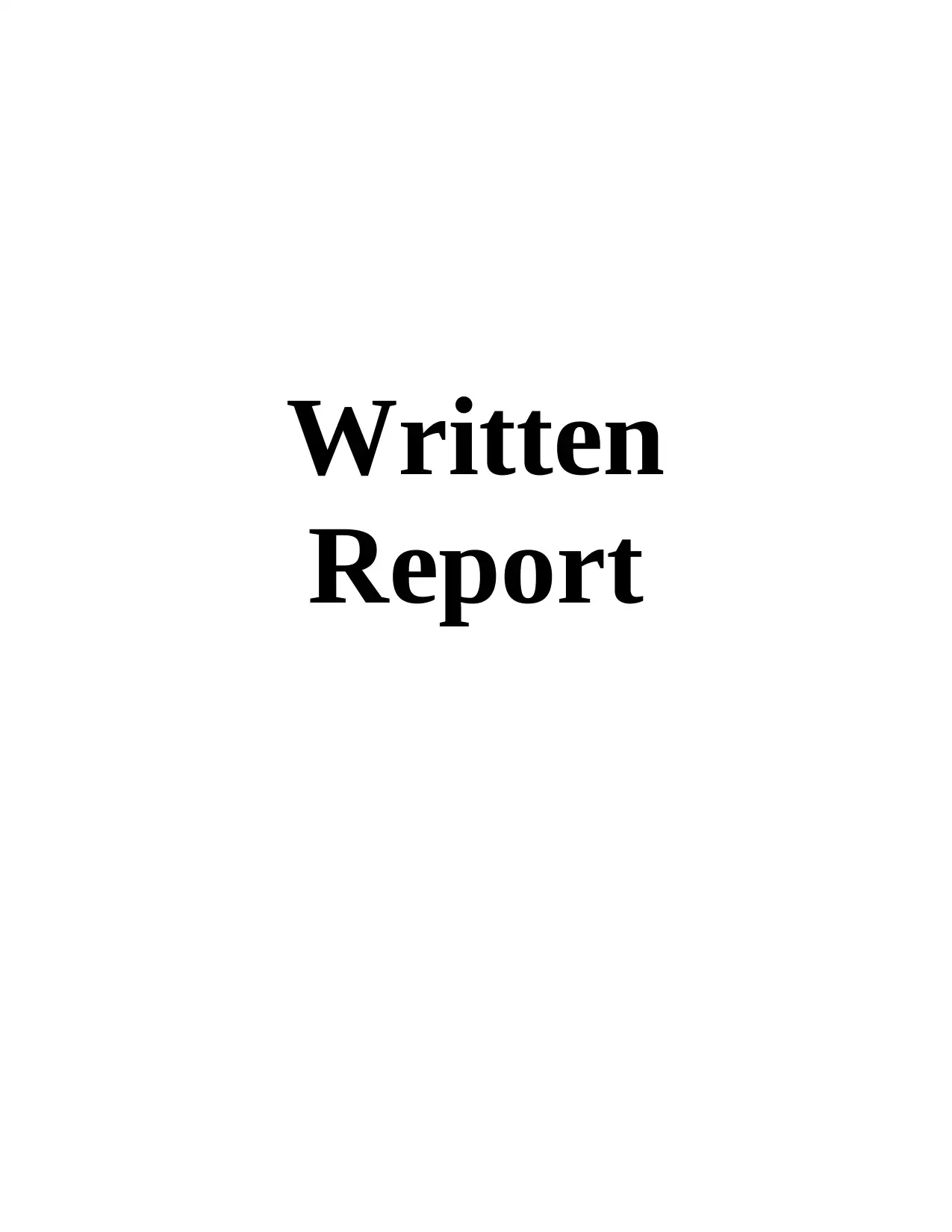
Written
Report
Report
Paraphrase This Document
Need a fresh take? Get an instant paraphrase of this document with our AI Paraphraser
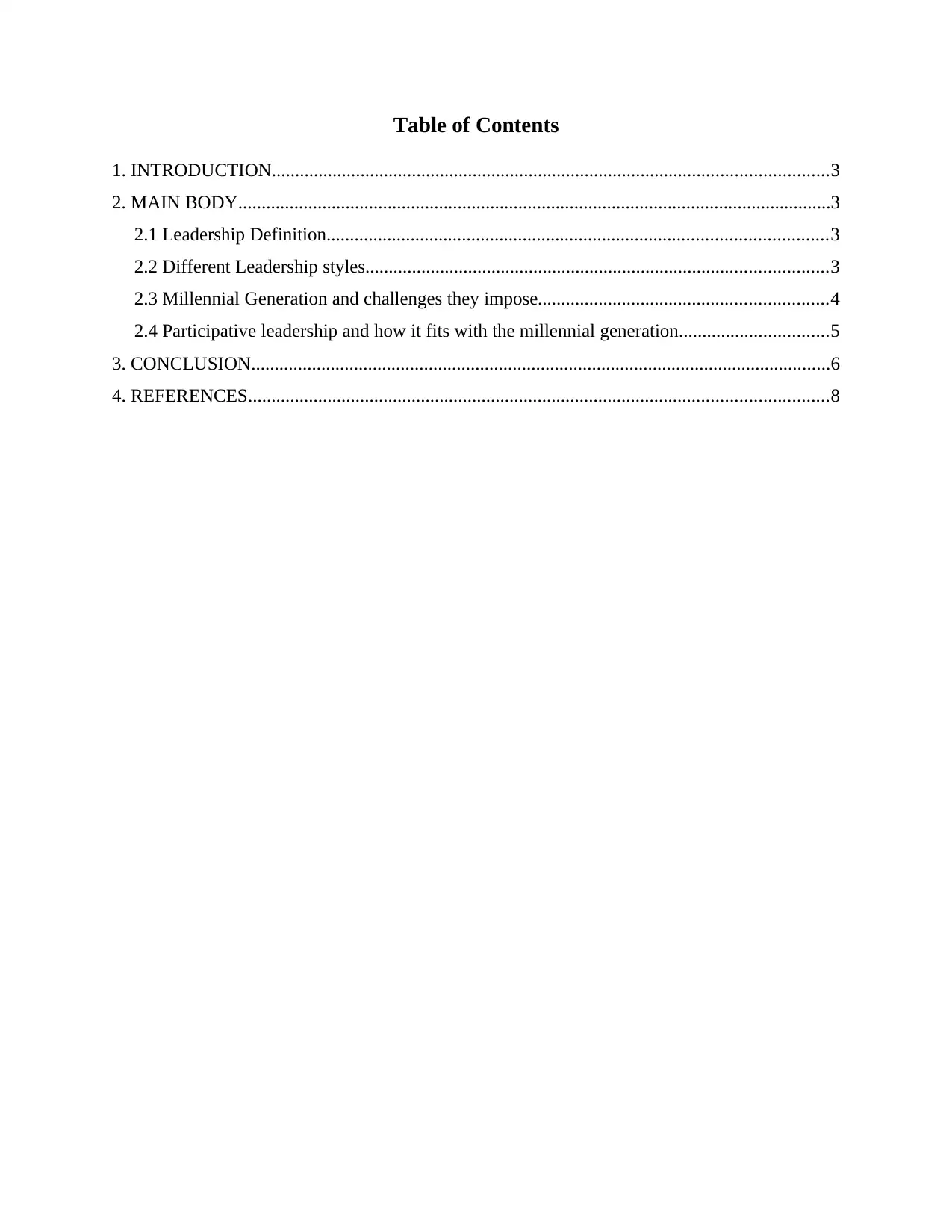
Table of Contents
1. INTRODUCTION.......................................................................................................................3
2. MAIN BODY...............................................................................................................................3
2.1 Leadership Definition...........................................................................................................3
2.2 Different Leadership styles...................................................................................................3
2.3 Millennial Generation and challenges they impose..............................................................4
2.4 Participative leadership and how it fits with the millennial generation................................5
3. CONCLUSION............................................................................................................................6
4. REFERENCES............................................................................................................................8
1. INTRODUCTION.......................................................................................................................3
2. MAIN BODY...............................................................................................................................3
2.1 Leadership Definition...........................................................................................................3
2.2 Different Leadership styles...................................................................................................3
2.3 Millennial Generation and challenges they impose..............................................................4
2.4 Participative leadership and how it fits with the millennial generation................................5
3. CONCLUSION............................................................................................................................6
4. REFERENCES............................................................................................................................8
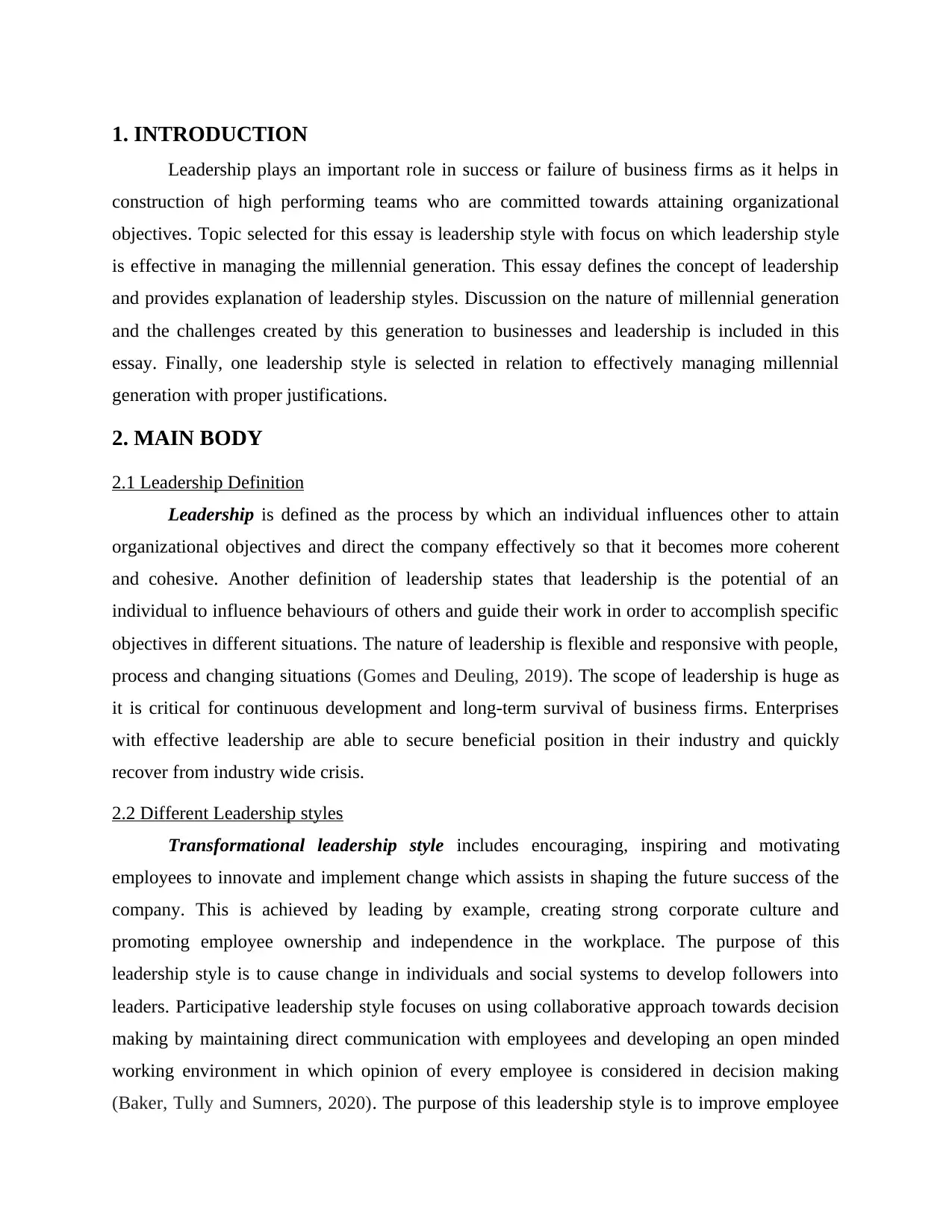
1. INTRODUCTION
Leadership plays an important role in success or failure of business firms as it helps in
construction of high performing teams who are committed towards attaining organizational
objectives. Topic selected for this essay is leadership style with focus on which leadership style
is effective in managing the millennial generation. This essay defines the concept of leadership
and provides explanation of leadership styles. Discussion on the nature of millennial generation
and the challenges created by this generation to businesses and leadership is included in this
essay. Finally, one leadership style is selected in relation to effectively managing millennial
generation with proper justifications.
2. MAIN BODY
2.1 Leadership Definition
Leadership is defined as the process by which an individual influences other to attain
organizational objectives and direct the company effectively so that it becomes more coherent
and cohesive. Another definition of leadership states that leadership is the potential of an
individual to influence behaviours of others and guide their work in order to accomplish specific
objectives in different situations. The nature of leadership is flexible and responsive with people,
process and changing situations (Gomes and Deuling, 2019). The scope of leadership is huge as
it is critical for continuous development and long-term survival of business firms. Enterprises
with effective leadership are able to secure beneficial position in their industry and quickly
recover from industry wide crisis.
2.2 Different Leadership styles
Transformational leadership style includes encouraging, inspiring and motivating
employees to innovate and implement change which assists in shaping the future success of the
company. This is achieved by leading by example, creating strong corporate culture and
promoting employee ownership and independence in the workplace. The purpose of this
leadership style is to cause change in individuals and social systems to develop followers into
leaders. Participative leadership style focuses on using collaborative approach towards decision
making by maintaining direct communication with employees and developing an open minded
working environment in which opinion of every employee is considered in decision making
(Baker, Tully and Sumners, 2020). The purpose of this leadership style is to improve employee
Leadership plays an important role in success or failure of business firms as it helps in
construction of high performing teams who are committed towards attaining organizational
objectives. Topic selected for this essay is leadership style with focus on which leadership style
is effective in managing the millennial generation. This essay defines the concept of leadership
and provides explanation of leadership styles. Discussion on the nature of millennial generation
and the challenges created by this generation to businesses and leadership is included in this
essay. Finally, one leadership style is selected in relation to effectively managing millennial
generation with proper justifications.
2. MAIN BODY
2.1 Leadership Definition
Leadership is defined as the process by which an individual influences other to attain
organizational objectives and direct the company effectively so that it becomes more coherent
and cohesive. Another definition of leadership states that leadership is the potential of an
individual to influence behaviours of others and guide their work in order to accomplish specific
objectives in different situations. The nature of leadership is flexible and responsive with people,
process and changing situations (Gomes and Deuling, 2019). The scope of leadership is huge as
it is critical for continuous development and long-term survival of business firms. Enterprises
with effective leadership are able to secure beneficial position in their industry and quickly
recover from industry wide crisis.
2.2 Different Leadership styles
Transformational leadership style includes encouraging, inspiring and motivating
employees to innovate and implement change which assists in shaping the future success of the
company. This is achieved by leading by example, creating strong corporate culture and
promoting employee ownership and independence in the workplace. The purpose of this
leadership style is to cause change in individuals and social systems to develop followers into
leaders. Participative leadership style focuses on using collaborative approach towards decision
making by maintaining direct communication with employees and developing an open minded
working environment in which opinion of every employee is considered in decision making
(Baker, Tully and Sumners, 2020). The purpose of this leadership style is to improve employee
⊘ This is a preview!⊘
Do you want full access?
Subscribe today to unlock all pages.

Trusted by 1+ million students worldwide
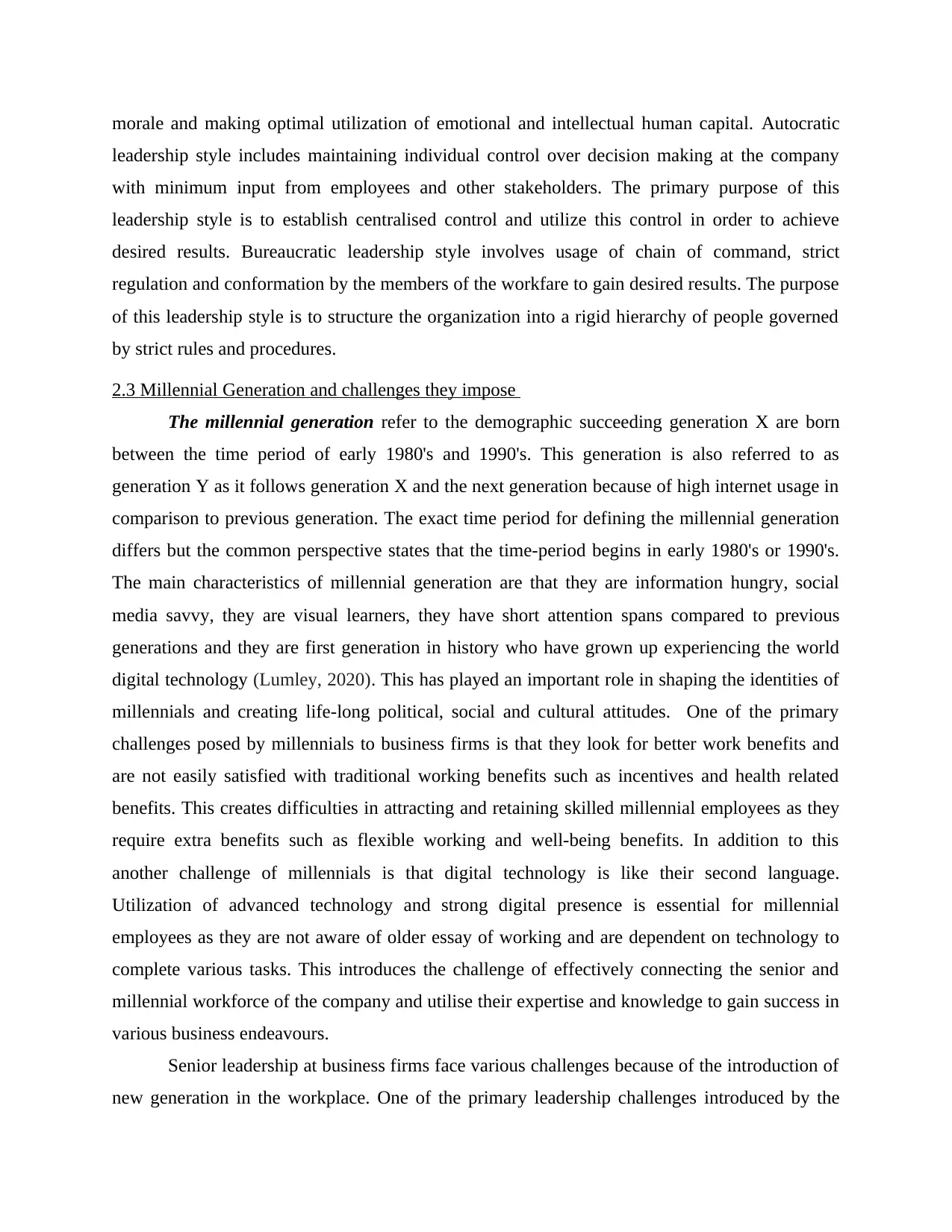
morale and making optimal utilization of emotional and intellectual human capital. Autocratic
leadership style includes maintaining individual control over decision making at the company
with minimum input from employees and other stakeholders. The primary purpose of this
leadership style is to establish centralised control and utilize this control in order to achieve
desired results. Bureaucratic leadership style involves usage of chain of command, strict
regulation and conformation by the members of the workfare to gain desired results. The purpose
of this leadership style is to structure the organization into a rigid hierarchy of people governed
by strict rules and procedures.
2.3 Millennial Generation and challenges they impose
The millennial generation refer to the demographic succeeding generation X are born
between the time period of early 1980's and 1990's. This generation is also referred to as
generation Y as it follows generation X and the next generation because of high internet usage in
comparison to previous generation. The exact time period for defining the millennial generation
differs but the common perspective states that the time-period begins in early 1980's or 1990's.
The main characteristics of millennial generation are that they are information hungry, social
media savvy, they are visual learners, they have short attention spans compared to previous
generations and they are first generation in history who have grown up experiencing the world
digital technology (Lumley, 2020). This has played an important role in shaping the identities of
millennials and creating life-long political, social and cultural attitudes. One of the primary
challenges posed by millennials to business firms is that they look for better work benefits and
are not easily satisfied with traditional working benefits such as incentives and health related
benefits. This creates difficulties in attracting and retaining skilled millennial employees as they
require extra benefits such as flexible working and well-being benefits. In addition to this
another challenge of millennials is that digital technology is like their second language.
Utilization of advanced technology and strong digital presence is essential for millennial
employees as they are not aware of older essay of working and are dependent on technology to
complete various tasks. This introduces the challenge of effectively connecting the senior and
millennial workforce of the company and utilise their expertise and knowledge to gain success in
various business endeavours.
Senior leadership at business firms face various challenges because of the introduction of
new generation in the workplace. One of the primary leadership challenges introduced by the
leadership style includes maintaining individual control over decision making at the company
with minimum input from employees and other stakeholders. The primary purpose of this
leadership style is to establish centralised control and utilize this control in order to achieve
desired results. Bureaucratic leadership style involves usage of chain of command, strict
regulation and conformation by the members of the workfare to gain desired results. The purpose
of this leadership style is to structure the organization into a rigid hierarchy of people governed
by strict rules and procedures.
2.3 Millennial Generation and challenges they impose
The millennial generation refer to the demographic succeeding generation X are born
between the time period of early 1980's and 1990's. This generation is also referred to as
generation Y as it follows generation X and the next generation because of high internet usage in
comparison to previous generation. The exact time period for defining the millennial generation
differs but the common perspective states that the time-period begins in early 1980's or 1990's.
The main characteristics of millennial generation are that they are information hungry, social
media savvy, they are visual learners, they have short attention spans compared to previous
generations and they are first generation in history who have grown up experiencing the world
digital technology (Lumley, 2020). This has played an important role in shaping the identities of
millennials and creating life-long political, social and cultural attitudes. One of the primary
challenges posed by millennials to business firms is that they look for better work benefits and
are not easily satisfied with traditional working benefits such as incentives and health related
benefits. This creates difficulties in attracting and retaining skilled millennial employees as they
require extra benefits such as flexible working and well-being benefits. In addition to this
another challenge of millennials is that digital technology is like their second language.
Utilization of advanced technology and strong digital presence is essential for millennial
employees as they are not aware of older essay of working and are dependent on technology to
complete various tasks. This introduces the challenge of effectively connecting the senior and
millennial workforce of the company and utilise their expertise and knowledge to gain success in
various business endeavours.
Senior leadership at business firms face various challenges because of the introduction of
new generation in the workplace. One of the primary leadership challenges introduced by the
Paraphrase This Document
Need a fresh take? Get an instant paraphrase of this document with our AI Paraphraser
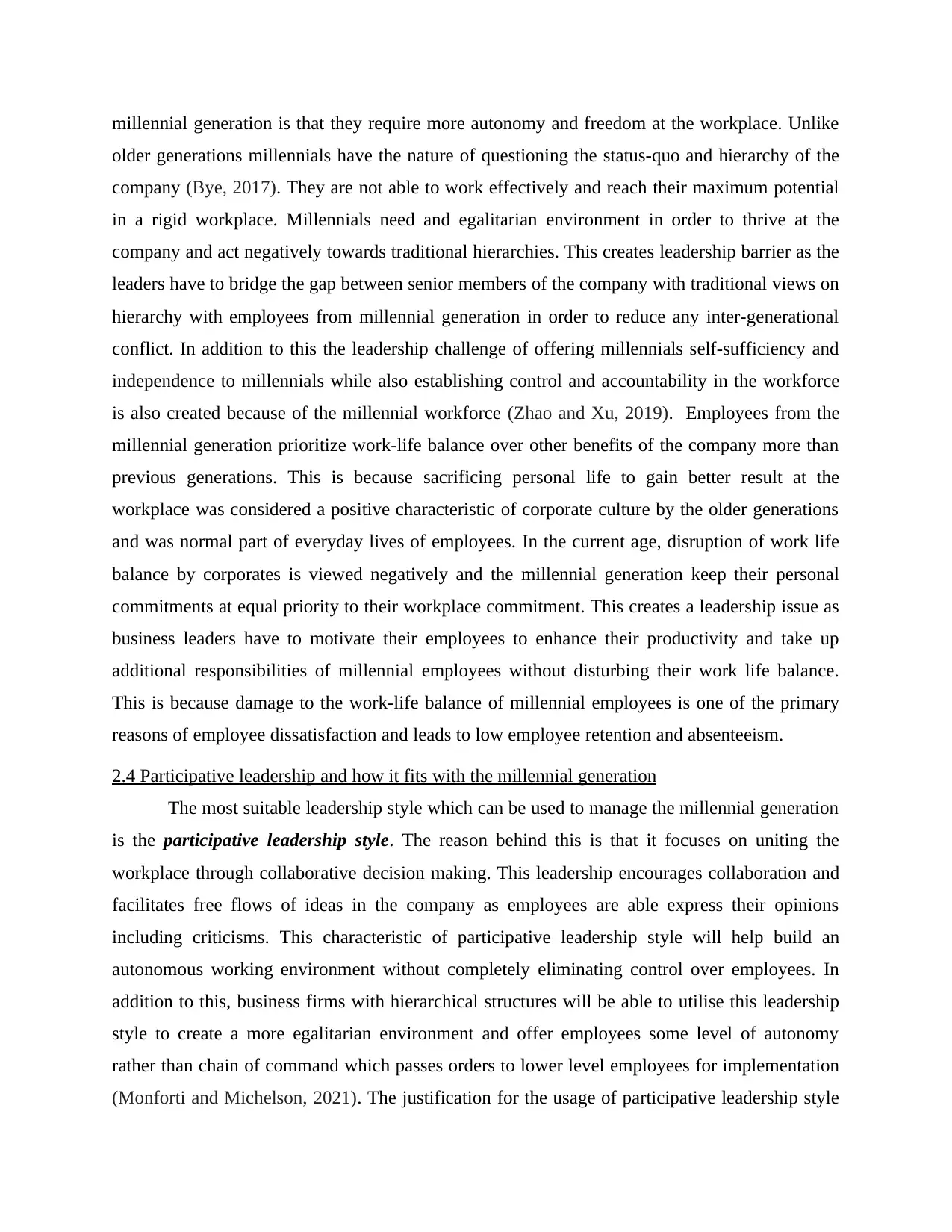
millennial generation is that they require more autonomy and freedom at the workplace. Unlike
older generations millennials have the nature of questioning the status-quo and hierarchy of the
company (Bye, 2017). They are not able to work effectively and reach their maximum potential
in a rigid workplace. Millennials need and egalitarian environment in order to thrive at the
company and act negatively towards traditional hierarchies. This creates leadership barrier as the
leaders have to bridge the gap between senior members of the company with traditional views on
hierarchy with employees from millennial generation in order to reduce any inter-generational
conflict. In addition to this the leadership challenge of offering millennials self-sufficiency and
independence to millennials while also establishing control and accountability in the workforce
is also created because of the millennial workforce (Zhao and Xu, 2019). Employees from the
millennial generation prioritize work-life balance over other benefits of the company more than
previous generations. This is because sacrificing personal life to gain better result at the
workplace was considered a positive characteristic of corporate culture by the older generations
and was normal part of everyday lives of employees. In the current age, disruption of work life
balance by corporates is viewed negatively and the millennial generation keep their personal
commitments at equal priority to their workplace commitment. This creates a leadership issue as
business leaders have to motivate their employees to enhance their productivity and take up
additional responsibilities of millennial employees without disturbing their work life balance.
This is because damage to the work-life balance of millennial employees is one of the primary
reasons of employee dissatisfaction and leads to low employee retention and absenteeism.
2.4 Participative leadership and how it fits with the millennial generation
The most suitable leadership style which can be used to manage the millennial generation
is the participative leadership style. The reason behind this is that it focuses on uniting the
workplace through collaborative decision making. This leadership encourages collaboration and
facilitates free flows of ideas in the company as employees are able express their opinions
including criticisms. This characteristic of participative leadership style will help build an
autonomous working environment without completely eliminating control over employees. In
addition to this, business firms with hierarchical structures will be able to utilise this leadership
style to create a more egalitarian environment and offer employees some level of autonomy
rather than chain of command which passes orders to lower level employees for implementation
(Monforti and Michelson, 2021). The justification for the usage of participative leadership style
older generations millennials have the nature of questioning the status-quo and hierarchy of the
company (Bye, 2017). They are not able to work effectively and reach their maximum potential
in a rigid workplace. Millennials need and egalitarian environment in order to thrive at the
company and act negatively towards traditional hierarchies. This creates leadership barrier as the
leaders have to bridge the gap between senior members of the company with traditional views on
hierarchy with employees from millennial generation in order to reduce any inter-generational
conflict. In addition to this the leadership challenge of offering millennials self-sufficiency and
independence to millennials while also establishing control and accountability in the workforce
is also created because of the millennial workforce (Zhao and Xu, 2019). Employees from the
millennial generation prioritize work-life balance over other benefits of the company more than
previous generations. This is because sacrificing personal life to gain better result at the
workplace was considered a positive characteristic of corporate culture by the older generations
and was normal part of everyday lives of employees. In the current age, disruption of work life
balance by corporates is viewed negatively and the millennial generation keep their personal
commitments at equal priority to their workplace commitment. This creates a leadership issue as
business leaders have to motivate their employees to enhance their productivity and take up
additional responsibilities of millennial employees without disturbing their work life balance.
This is because damage to the work-life balance of millennial employees is one of the primary
reasons of employee dissatisfaction and leads to low employee retention and absenteeism.
2.4 Participative leadership and how it fits with the millennial generation
The most suitable leadership style which can be used to manage the millennial generation
is the participative leadership style. The reason behind this is that it focuses on uniting the
workplace through collaborative decision making. This leadership encourages collaboration and
facilitates free flows of ideas in the company as employees are able express their opinions
including criticisms. This characteristic of participative leadership style will help build an
autonomous working environment without completely eliminating control over employees. In
addition to this, business firms with hierarchical structures will be able to utilise this leadership
style to create a more egalitarian environment and offer employees some level of autonomy
rather than chain of command which passes orders to lower level employees for implementation
(Monforti and Michelson, 2021). The justification for the usage of participative leadership style
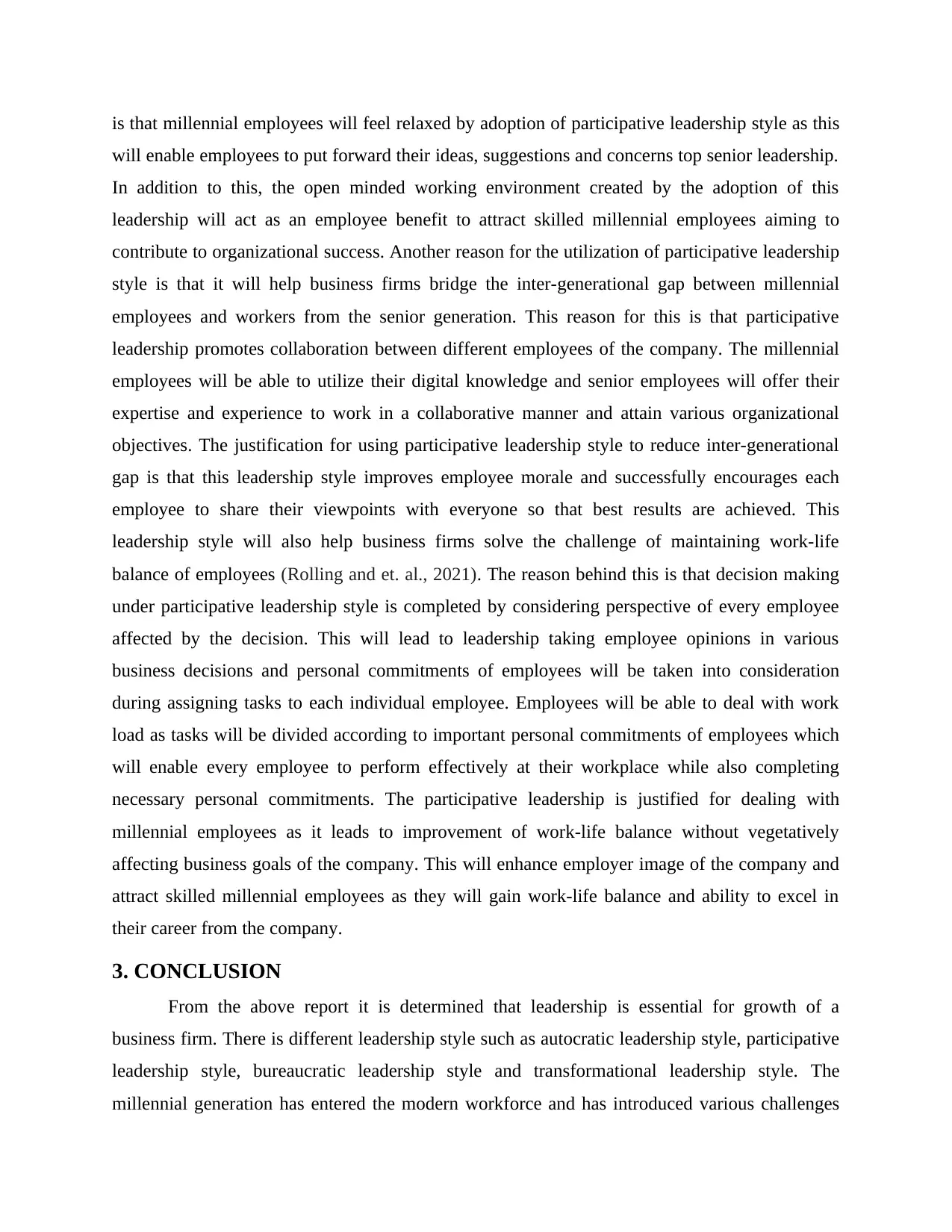
is that millennial employees will feel relaxed by adoption of participative leadership style as this
will enable employees to put forward their ideas, suggestions and concerns top senior leadership.
In addition to this, the open minded working environment created by the adoption of this
leadership will act as an employee benefit to attract skilled millennial employees aiming to
contribute to organizational success. Another reason for the utilization of participative leadership
style is that it will help business firms bridge the inter-generational gap between millennial
employees and workers from the senior generation. This reason for this is that participative
leadership promotes collaboration between different employees of the company. The millennial
employees will be able to utilize their digital knowledge and senior employees will offer their
expertise and experience to work in a collaborative manner and attain various organizational
objectives. The justification for using participative leadership style to reduce inter-generational
gap is that this leadership style improves employee morale and successfully encourages each
employee to share their viewpoints with everyone so that best results are achieved. This
leadership style will also help business firms solve the challenge of maintaining work-life
balance of employees (Rolling and et. al., 2021). The reason behind this is that decision making
under participative leadership style is completed by considering perspective of every employee
affected by the decision. This will lead to leadership taking employee opinions in various
business decisions and personal commitments of employees will be taken into consideration
during assigning tasks to each individual employee. Employees will be able to deal with work
load as tasks will be divided according to important personal commitments of employees which
will enable every employee to perform effectively at their workplace while also completing
necessary personal commitments. The participative leadership is justified for dealing with
millennial employees as it leads to improvement of work-life balance without vegetatively
affecting business goals of the company. This will enhance employer image of the company and
attract skilled millennial employees as they will gain work-life balance and ability to excel in
their career from the company.
3. CONCLUSION
From the above report it is determined that leadership is essential for growth of a
business firm. There is different leadership style such as autocratic leadership style, participative
leadership style, bureaucratic leadership style and transformational leadership style. The
millennial generation has entered the modern workforce and has introduced various challenges
will enable employees to put forward their ideas, suggestions and concerns top senior leadership.
In addition to this, the open minded working environment created by the adoption of this
leadership will act as an employee benefit to attract skilled millennial employees aiming to
contribute to organizational success. Another reason for the utilization of participative leadership
style is that it will help business firms bridge the inter-generational gap between millennial
employees and workers from the senior generation. This reason for this is that participative
leadership promotes collaboration between different employees of the company. The millennial
employees will be able to utilize their digital knowledge and senior employees will offer their
expertise and experience to work in a collaborative manner and attain various organizational
objectives. The justification for using participative leadership style to reduce inter-generational
gap is that this leadership style improves employee morale and successfully encourages each
employee to share their viewpoints with everyone so that best results are achieved. This
leadership style will also help business firms solve the challenge of maintaining work-life
balance of employees (Rolling and et. al., 2021). The reason behind this is that decision making
under participative leadership style is completed by considering perspective of every employee
affected by the decision. This will lead to leadership taking employee opinions in various
business decisions and personal commitments of employees will be taken into consideration
during assigning tasks to each individual employee. Employees will be able to deal with work
load as tasks will be divided according to important personal commitments of employees which
will enable every employee to perform effectively at their workplace while also completing
necessary personal commitments. The participative leadership is justified for dealing with
millennial employees as it leads to improvement of work-life balance without vegetatively
affecting business goals of the company. This will enhance employer image of the company and
attract skilled millennial employees as they will gain work-life balance and ability to excel in
their career from the company.
3. CONCLUSION
From the above report it is determined that leadership is essential for growth of a
business firm. There is different leadership style such as autocratic leadership style, participative
leadership style, bureaucratic leadership style and transformational leadership style. The
millennial generation has entered the modern workforce and has introduced various challenges
⊘ This is a preview!⊘
Do you want full access?
Subscribe today to unlock all pages.

Trusted by 1+ million students worldwide
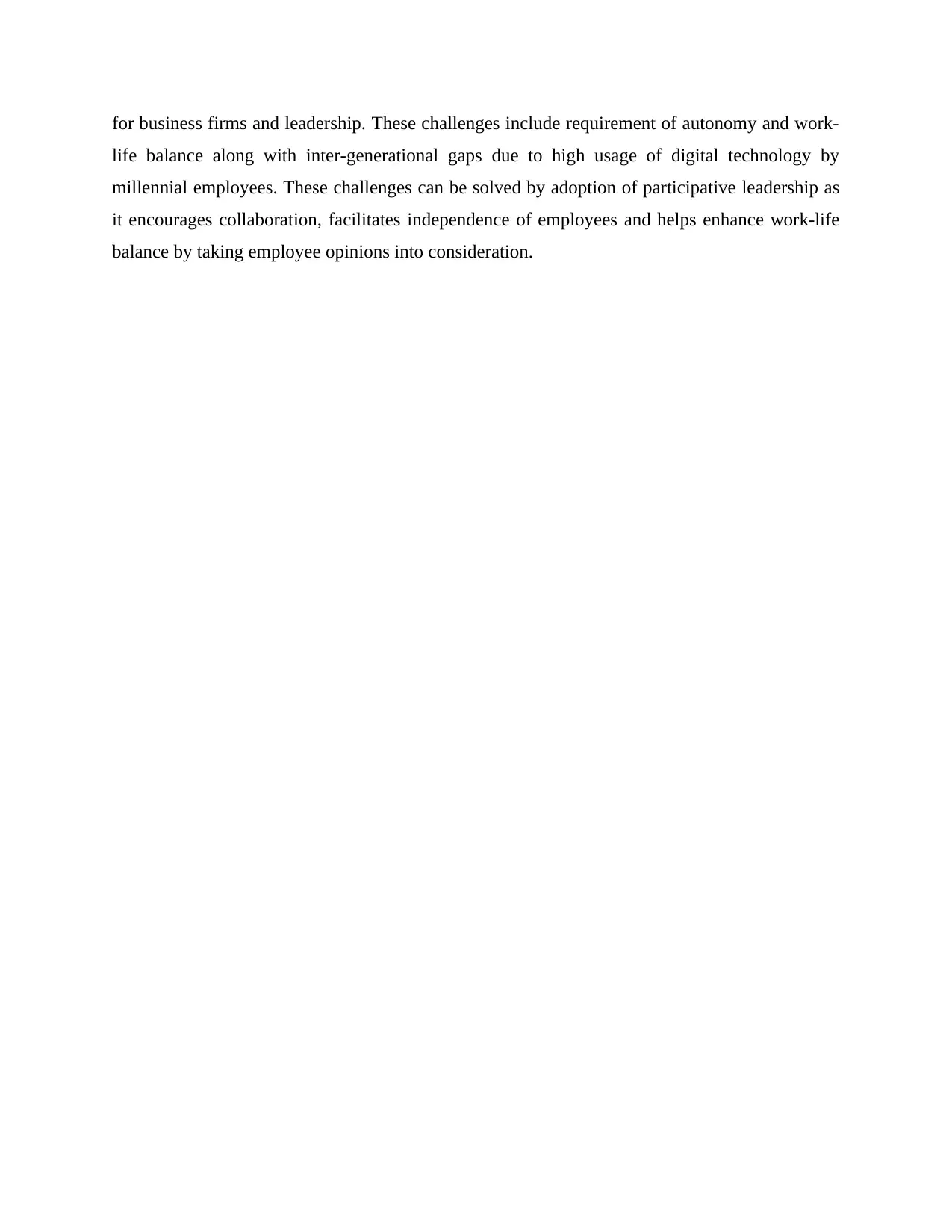
for business firms and leadership. These challenges include requirement of autonomy and work-
life balance along with inter-generational gaps due to high usage of digital technology by
millennial employees. These challenges can be solved by adoption of participative leadership as
it encourages collaboration, facilitates independence of employees and helps enhance work-life
balance by taking employee opinions into consideration.
life balance along with inter-generational gaps due to high usage of digital technology by
millennial employees. These challenges can be solved by adoption of participative leadership as
it encourages collaboration, facilitates independence of employees and helps enhance work-life
balance by taking employee opinions into consideration.
Paraphrase This Document
Need a fresh take? Get an instant paraphrase of this document with our AI Paraphraser
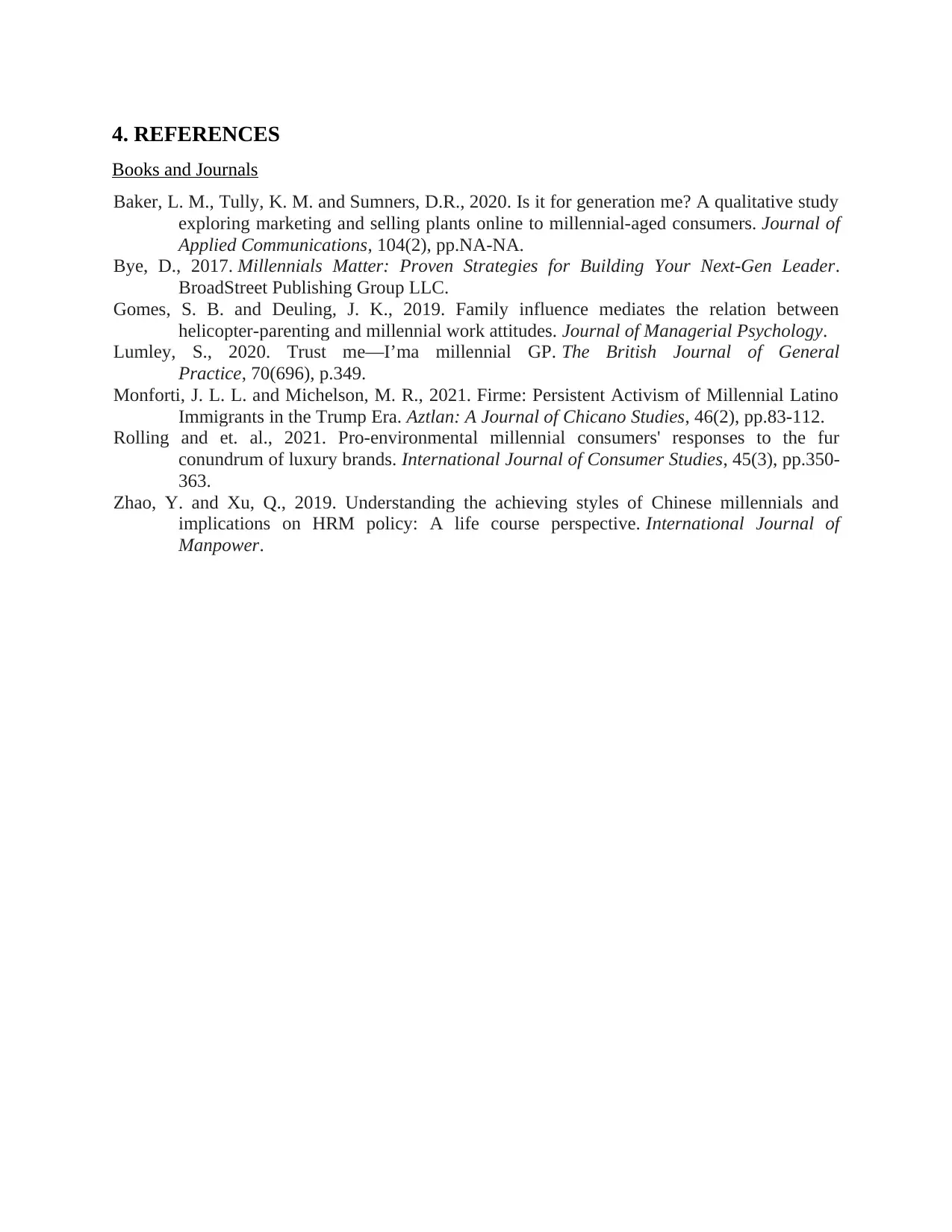
4. REFERENCES
Books and Journals
Baker, L. M., Tully, K. M. and Sumners, D.R., 2020. Is it for generation me? A qualitative study
exploring marketing and selling plants online to millennial-aged consumers. Journal of
Applied Communications, 104(2), pp.NA-NA.
Bye, D., 2017. Millennials Matter: Proven Strategies for Building Your Next-Gen Leader.
BroadStreet Publishing Group LLC.
Gomes, S. B. and Deuling, J. K., 2019. Family influence mediates the relation between
helicopter-parenting and millennial work attitudes. Journal of Managerial Psychology.
Lumley, S., 2020. Trust me—I’ma millennial GP. The British Journal of General
Practice, 70(696), p.349.
Monforti, J. L. L. and Michelson, M. R., 2021. Firme: Persistent Activism of Millennial Latino
Immigrants in the Trump Era. Aztlan: A Journal of Chicano Studies, 46(2), pp.83-112.
Rolling and et. al., 2021. Pro‐environmental millennial consumers' responses to the fur
conundrum of luxury brands. International Journal of Consumer Studies, 45(3), pp.350-
363.
Zhao, Y. and Xu, Q., 2019. Understanding the achieving styles of Chinese millennials and
implications on HRM policy: A life course perspective. International Journal of
Manpower.
Books and Journals
Baker, L. M., Tully, K. M. and Sumners, D.R., 2020. Is it for generation me? A qualitative study
exploring marketing and selling plants online to millennial-aged consumers. Journal of
Applied Communications, 104(2), pp.NA-NA.
Bye, D., 2017. Millennials Matter: Proven Strategies for Building Your Next-Gen Leader.
BroadStreet Publishing Group LLC.
Gomes, S. B. and Deuling, J. K., 2019. Family influence mediates the relation between
helicopter-parenting and millennial work attitudes. Journal of Managerial Psychology.
Lumley, S., 2020. Trust me—I’ma millennial GP. The British Journal of General
Practice, 70(696), p.349.
Monforti, J. L. L. and Michelson, M. R., 2021. Firme: Persistent Activism of Millennial Latino
Immigrants in the Trump Era. Aztlan: A Journal of Chicano Studies, 46(2), pp.83-112.
Rolling and et. al., 2021. Pro‐environmental millennial consumers' responses to the fur
conundrum of luxury brands. International Journal of Consumer Studies, 45(3), pp.350-
363.
Zhao, Y. and Xu, Q., 2019. Understanding the achieving styles of Chinese millennials and
implications on HRM policy: A life course perspective. International Journal of
Manpower.
1 out of 8
Related Documents
Your All-in-One AI-Powered Toolkit for Academic Success.
+13062052269
info@desklib.com
Available 24*7 on WhatsApp / Email
![[object Object]](/_next/static/media/star-bottom.7253800d.svg)
Unlock your academic potential
Copyright © 2020–2025 A2Z Services. All Rights Reserved. Developed and managed by ZUCOL.





